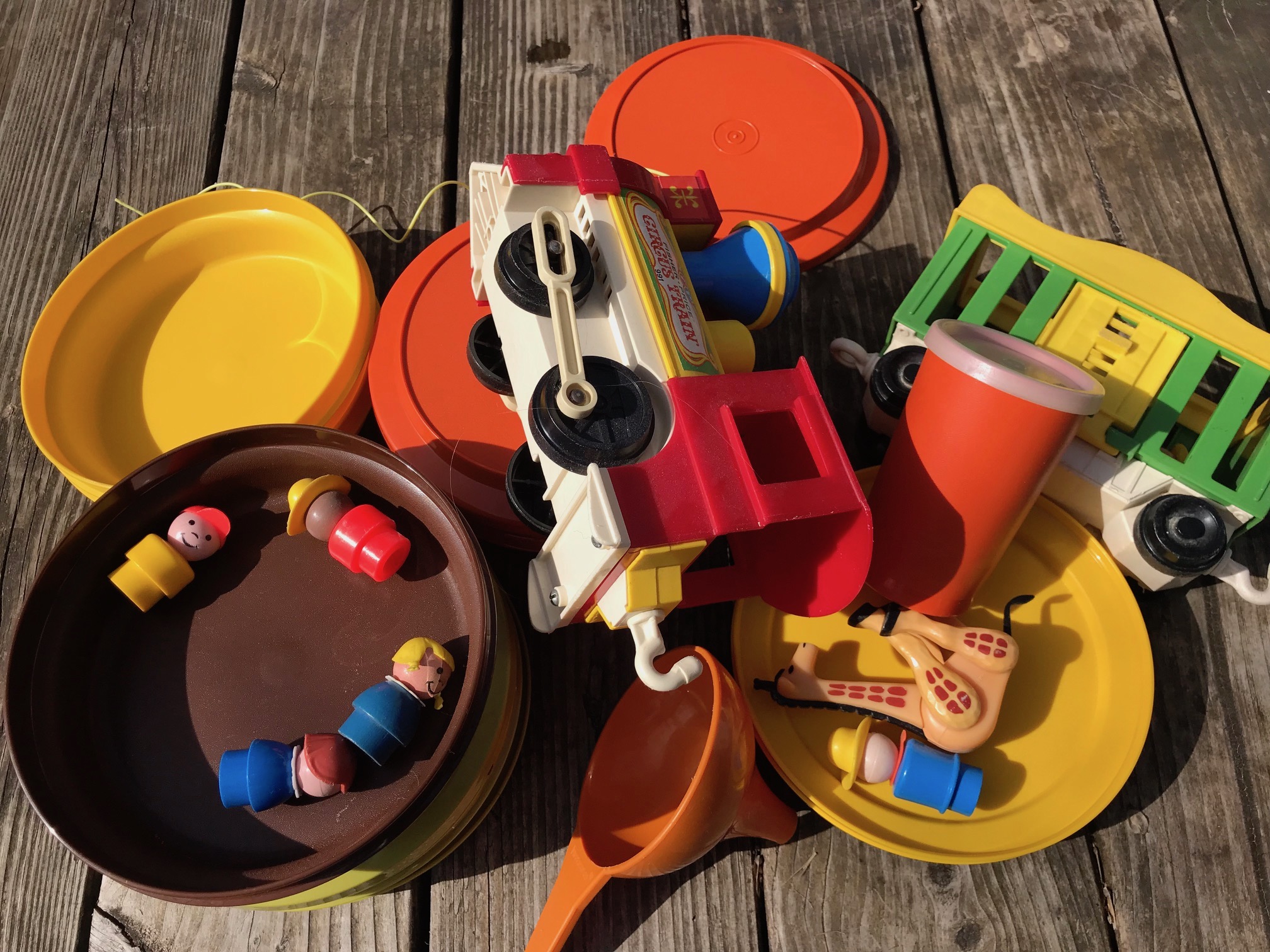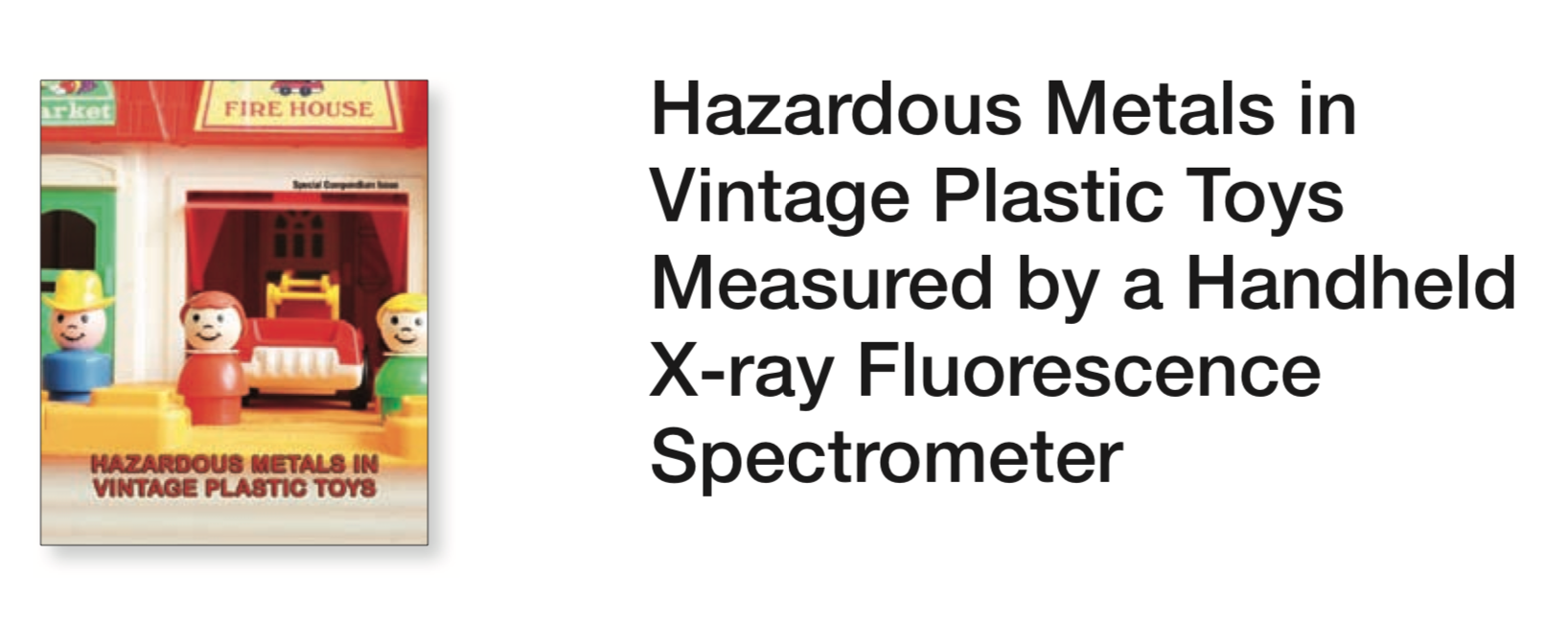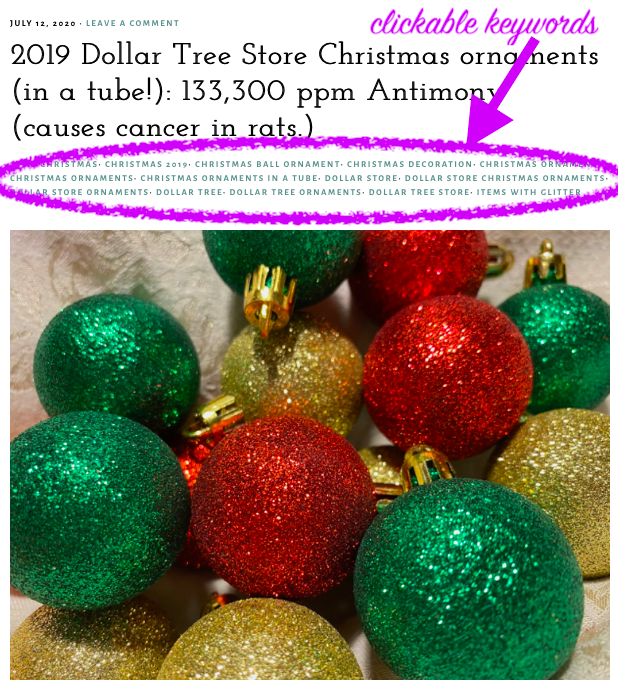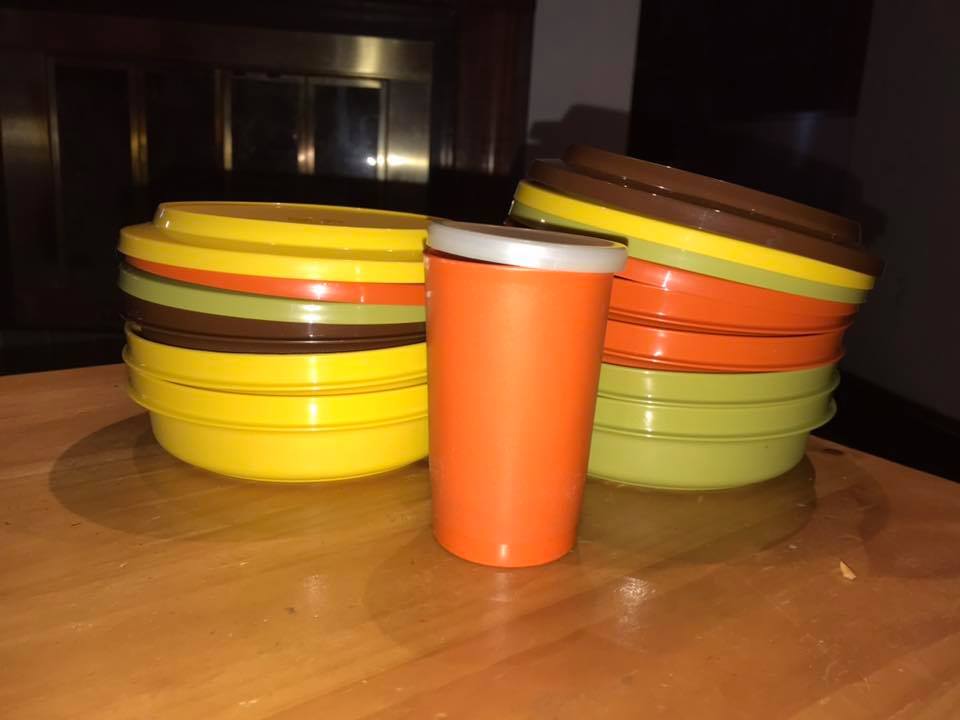Why do VINTAGE plastics (like Fisher Price & Tupperware) often contain Lead, Mercury, Arsenic, & Cadmium?
For starters, please consider reading this linked study (click the image below) which discusses this concern in detail:
There are two reasons vintage plastics often have Lead:
- In brightly-colored vintage plastics, the metallic toxicants (Lead, Mercury, Arsenic, and Cadmium) are often used as components of colorants in the plastics.
- I have also found that vintage flexible/pliable plastic and rubber items (like electric cords, Christmas lights, extension cords, and similar) often have high levels of Lead — regardless of the color. Years ago it was explained to me (by a research-scientist friend of mine who had direct knowledge of the subject) that this was because these plastics were likely treated with Lead in the forming process for two reasons: either to make them/keep them flexible and supple (less prone to brittleness & cracking), and/or to imbue some degree of flame-retardancy to the ones that are specifically electrical in nature. In newly-manufactured electrical cords, one can still sometimes find Lead, but now Antimony has become more prevalent – likely due to it’s touted flame-retardant properties.
Some Tupperware-specific test results here on the blog – by color.
For the recent vintage Tupperware testing I have done, I found the following examples (I will update this as I post more examples of different colors):
- Brown plastic Tupperware: No Lead, Mercury, Arsenic or Cadmium [Link]
- —–
- Light yellow plastic Tupperware: Positive for Lead and Arsenic [Link]
- Olive green plastic Tupperware: Positive for Lead and Arsenic [Link]
- —–
- Bright yellow plastic Tupperware: Positive for Cadmium and Mercury [Link]
- Orange plastic Tupperware (two examples, similar results): Positive for Cadmium and Mercury [Link]
From the linked study above:
“Why are hazardous metals present in so many old non-vinyl toys? The metals are almost certainly colorants or pigments. Lead Chromate (PbCrO4) – also known as “Chrome Yellow” – was a standard plastic colorant in the era in which these toys were made. Lead Sulfate (PbSO4), and Lead Oxide (PbO), were mixed with the Chromate in varying amounts to produce a color palette from light yellow to red (Rangos, 2003).
Similarly, Cadmium compounds, such as Cadmium Sulfide, and Cadmium Selenide were — and still are —used to produce yellow and orange hues in plastics (Rangos, 2003; Vonke- man, Thornton, & Makuch, 2001). Mercury/Cadmium Sulfides were also used to produce colors from orange to maroon (Rangos, 2003).”
Collectors and brand loyalists are pretty unhappy about this information!
Of course, Tupperware fans have been very upset about the test results that I have shared recently (of my findings of toxicants in vintage Tupperware products), but the important thing to emphasize is that this is VINTAGE product — things made 40 to 50 years ago. This is not likely a concern for any of the new product (as, for a newly-manufactured plastic product to test positive for these toxicants at these levels, would be a violation of the subsequently-enacted contemporary regulatory standards.)
Why was it allowed for these products to contain toxic heavy metals?
- When these vintage products were produced, regulatory standards for consumer goods ranged from being non-existent to ineffective (not protective of human health).
- Additionally, when these products were made the compact, portable scientific instruments and software (like the XRF instrument I use in my work) enabling spot-testing/field-analysis of consumer goods did not yet exist — and the instrumentation that did exist was not able to detect toxicants at the levels (and with the degree of precision, accuracy and specificity) of modern instrumentation.
Are you curious about the toxicants profile for specific product you own?
There are over 2,500 posts and pages here on this website – most with product-specific information. Here’s how to use this site to find what you are looking for (or to find something similar that might give you an idea about the specific product you are concerned about):
For those new to the site, note that there is a search bar on each and every page (either in the righthand menu, or at the top or at the bottom of each page — depending on what browser you are using). The key to using this search bar is to enter fewer words if you want to see more results. For example, you can enter “Christmas” (or “Santa“, or “Christmas Ornament”, or “Christmas China” or any other similar short search terms) to see the items pictured in the header image and more.
You can also click on any of the keywords in the list at the top of each post, and you will automatically be taken to a list of posts for that category of items. Here’s an example of the clickable keywords at the top of post (continue reading below the image):
This image shows the clickable keywords at the top of each post, circled in purple.
Once you have your search category pulled up, click on each item pictured in the search results to read about the specific toxicants profile (the specific XRF-detectable heavy metal toxicants content – as well as other [non-concerning] metals found in the items) for the item pictured. Most posts will also offer safer alternatives (if the item you are looking up has tested positive for Lead, Cadmium, Mercury, Arsenic, or Antimony.)
Here are some specific categories to get you started in your search:
- Vintage Plastic
- Vintage red plastic
- Vintage yellow plastic
- Vintage Legos
- Vintage vinyl
- Vintage records
- Vintage orange plastic
- Vintage Fisher Price
- Vintage Tupperware
- Vinyl measuring tapes (sewing)
As always, Thank You for reading and for sharing my posts. Please let me know if you have any questions — I will do my best to answer them personally, as soon as I have a moment.
Tamara Rubin
#LeadSafeMama
Introduction to Tamara (for those new to the site!)
Tamara Rubin lives in Portland, Oregon and is a child health advocate, author, documentary filmmaker, and mother of four sons. Her four sons are now 24, 18, 15, and 12. She has won multiple national awards for her Lead-poisoning prevention advocacy work (including two from U.S. government agencies). As of November 15, 2020, she has had more than 1.5 million unique individual readers visit her blog in the past 12 months (with over 3.5 million page views!) – from more than 200 countries around the world!
It is with the help, support, and participation of these readers that she conducts and reports on independent testing of consumer goods for toxicants (Lead, Mercury, Arsenic, Cadmium, and Antimony), using high-accuracy X-Ray Fluoresence analysis (read more about that here). She goes by #LeadSafeMama on Twitter, Facebook & Instagram and has over 2,500 separate posts of information (mostly consumer goods test results) on her blog at LeadSafeMama.com.
Tamara’s advocacy work has been mentioned in print in The New York Times; the New York Post; Mother Jones; Parents Magazine; Vice.com; MNN.com; TruthOut; WebMD; the Huffington Post,;USA Today; Grok Nation, and more (too many outlets to list!) – and in other media (T.V. and radio), on the Today Show; Kids in the House; Al Jazeera English; The Voice of Russia; CBS This Morning, and through news stories on CBS; ABC; NBC, and even Fox News – as well as in countless podcasts and other interviews.
Never Miss an Important Article Again!
Join our Email List







What about Noah’s Ark and other Tuppertoys? I have some over 30 years old. Am I poisoning my grandchildren?
How should I dispose of these items? I assume putting them in the trash is not a good idea.
Go to the homepage of this website and there’s a direct link on what to do with these types of items. In a nutshell, trash them.